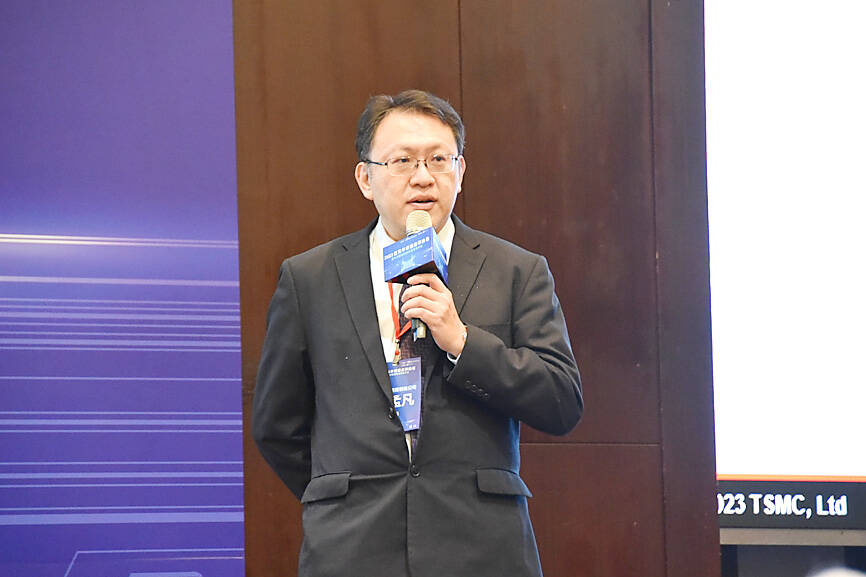Taiwan’s semiconductor industry faces multiple challenges, from the need to conduct further research into forward-looking technologies to a shortage of talent, an industry executive said on Wednesday.
Advancing forward-looking semiconductor research and nurturing talent require long-term joint efforts by the industry, government and academia, Taiwan Semiconductor Manufacturing Co (TSMC, 台積電) corporate research director Marvin Chang (張孟凡) said.
Chang outlined the challenges in a speech at a semiconductor forum organized by the National Science and Technology Council (NTSC) in Hsinchu.

Photo: Wu Po-hsuan, Taipei Times
Noting that manufacturers have been deploying fin field-effect transistor (FinFET) technology for more than a decade to develop advanced microprocessors, Chang said nanosheet is the next promising technology likely to go beyond the performance limitations of FinFET.
Complementary field-effect transistors, which has great potential to transcend 3-nanometer technology, and carbon nanotubes — nanoscale hollow tubes composed of carbon atoms — might also be developed, he said.
However, the academic sector will have to lead in exploring the benefits of these emerging technologies, he said.
Taiwan used to focus on short-term semiconductor development, but given its position as a world leader in semiconductors, the government and enterprises should attach greater importance to the mid to long-term research and development (R&D) of new technologies, he added.
Other than making breakthroughs in the miniaturization of transistors, developing the manufacturing technology to produce three-dimensional integrated circuits (3DICs) that fully utilize and optimize silicon across all three dimensions to perform system-level integration with a smaller package size and higher interconnection density is also important, Chang said.
The technology offers big payoffs in performance, power and area, Chang said, referring to the three variables used in deciding how to optimize chip designs.
However, Taiwan has a short supply of workers in this area and in electronic design automation, he said.
Cooperation between TSMC’s manufacturing process R&D and design teams continues to increase, with the participation rate of its designers in 3-nanometer process R&D having reached 50 percent and is expected to continue rising, he said.
The demand for semiconductor talent is not limited to a single field, Chang said.
For example, TSMC needs more people in research and development, operations technology, strategy and support, he added.
Moreover, while FinFET architecture has been deployed for more than a decade, academic research is still confined to traditional transistor architecture, he said.
This illustrates the large gap between academic research and industrial applications, given the expenditure needed to train new recruits, he added.
Meanwhile, NSTC Minister Wu Tsung-tsong (吳政忠) said that Taiwan needs to reinforce development of its IC design industry, one of the main sources of industrial applications and the driving force for the development of the semiconductor industry.
The council plans to set up a semiconductor base in Europe to attract international IC design talent and send them to Taiwan, he said.
The government aims to build Taiwan into an international IC design center by 2035 through interministerial cooperation, he added.
Taiwan’s IC design industry ranks second in the world and needs high-quality engineering talent, MediaTek Inc (聯發科) senior corporate vice president Lawrence Loh (陸國宏) said.
Voicing his concern over Taiwan’s lower numbers of engineers compared with the US, Europe, China and South Korea, Loh suggested that Taiwan consider recruiting foreign professionals to the country, setting up research and development bases overseas, and continuing to encourage Taiwanese talent overseas to return home.
He also said the country should prevent foreign businesses from poaching Taiwan’s top-end IC design talent.

To many, Tatu City on the outskirts of Nairobi looks like a success. The first city entirely built by a private company to be operational in east Africa, with about 25,000 people living and working there, it accounts for about two-thirds of all foreign investment in Kenya. Its low-tax status has attracted more than 100 businesses including Heineken, coffee brand Dormans, and the biggest call-center and cold-chain transport firms in the region. However, to some local politicians, Tatu City has looked more like a target for extortion. A parade of governors have demanded land worth millions of dollars in exchange

Hong Kong authorities ramped up sales of the local dollar as the greenback’s slide threatened the foreign-exchange peg. The Hong Kong Monetary Authority (HKMA) sold a record HK$60.5 billion (US$7.8 billion) of the city’s currency, according to an alert sent on its Bloomberg page yesterday in Asia, after it tested the upper end of its trading band. That added to the HK$56.1 billion of sales versus the greenback since Friday. The rapid intervention signals efforts from the city’s authorities to limit the local currency’s moves within its HK$7.75 to HK$7.85 per US dollar trading band. Heavy sales of the local dollar by

Taiwan Semiconductor Manufacturing Co’s (TSMC, 台積電) revenue jumped 48 percent last month, underscoring how electronics firms scrambled to acquire essential components before global tariffs took effect. The main chipmaker for Apple Inc and Nvidia Corp reported monthly sales of NT$349.6 billion (US$11.6 billion). That compares with the average analysts’ estimate for a 38 percent rise in second-quarter revenue. US President Donald Trump’s trade war is prompting economists to retool GDP forecasts worldwide, casting doubt over the outlook for everything from iPhone demand to computing and datacenter construction. However, TSMC — a barometer for global tech spending given its central role in the

An Indonesian animated movie is smashing regional box office records and could be set for wider success as it prepares to open beyond the Southeast Asian archipelago’s silver screens. Jumbo — a film based on the adventures of main character, Don, a large orphaned Indonesian boy facing bullying at school — last month became the highest-grossing Southeast Asian animated film, raking in more than US$8 million. Released at the end of March to coincide with the Eid holidays after the Islamic fasting month of Ramadan, the movie has hit 8 million ticket sales, the third-highest in Indonesian cinema history, Film